
The West Virginia State Capitol is the seat of government for the U.S. state of West Virginia, and houses the West Virginia Legislature and the office of the Governor of West Virginia. Located in Charleston, West Virginia, the building was dedicated in 1932. Along with the West Virginia Executive Mansion it is part of the West Virginia Capitol Complex, a historic district listed on the National Register of Historic Places.

The Henry K. List House, also known as the Wheeling-Moundsville Chapter of the American Red Cross, is a historic home located at 827 Main Street in Wheeling, Ohio County, West Virginia. It was built in 1858, and consists of a two-story square main block with an offset two-story rear wing. The brick mansion features a low-pitched hipped roof with a balustraded square cupola. It has Renaissance Revival and Italianate design details. The building was once occupied by the Ohio Valley Red Cross.

West Virginia Independence Hall is a historic government building at 1528 Market Street in downtown Wheeling, West Virginia, United States. It was built in 1860 under the supervision of architect Ammi B. Young for the federal government as a custom house, post office and courthouse. It is architecturally significant for its innovative uses of wrought iron as a framing material, and is historically significant for its role in the American Civil War. It housed the Wheeling Convention (1861), as well as the West Virginia Constitutional Convention (1863), which resulted in the separation of Unionist West Virginia from Confederate Virginia. This made it the only state to secede from a Confederate state during the war. The building was originally built as the custom house for the Western District of Virginia, and later became the center of government for the Restored Government of Virginia from 1861 to 1863, with Francis H. Pierpont serving as its governor. It was declared a National Historic Landmark in 1988. The building is now a state-run museum, housing exhibits on West Virginia history.
Klieves, Kraft & Company was a building contractor and architectural firm in Wheeling, West Virginia. The firm was involved in the construction of West Virginia University's Woodburn Hall in the 1870s, among other historic structures in the state of West Virginia.

The Lower Basin Historic District is a national historic district located in Lynchburg, Virginia. The district defines a commercial and industrial warehouse area located between the downtown commercial area to the south and the James River waterfront to the north. The district contains a variety of mostly late 19th- and early 20th-century, multi-story, brick warehouses and factories, two-to-three-story brick commercial buildings, and a number of structures associated with the James River and Kanawha Canal and the Norfolk and Western and Chesapeake and Ohio Railways. The district is named for a wide basin of the canal that once extended between Ninth Street and Horseford Road, and contains 60 contributing buildings, two contributing structures, and one contributing object-a monument commemorating the site of 18th-century Lynch's Ferry.
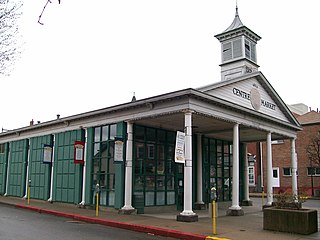
The Center Wheeling Market is a historic public market located along Market Street between 22nd and 23rd Streets in Wheeling, Ohio County, West Virginia. It consists of the Center Wheeling Market building as well as the Center Wheeling Fish Market. The 1853 Center Wheeling Market building was designed by architect Thomas Pope as an open market. The building is of neo-classical style with three bays and structural cast iron Doric order columns. It has a gable roof and features a belfry complete with bell. The 1890 open brick, neo-Romanesque section was designed by Wheeling architect Edward B. Franzheim. It has brick piers that support a hipped roof with cross gables and a three-foot overhang. In 1900, a wooden enclosure was built at the northern bay to house the Center Wheeling Fish Market.

Cameron Downtown Historic District is a national historic district located at Cameron, Marshall County, West Virginia. It encompasses 27 contributing buildings in the commercial core developed after a severe fire in 1895 which destroyed much of the downtown area. They are large 2-4 story brick buildings reflecting the Classical Revival and Colonial Revival styles. Notable buildings include the Masonic Lodge 17, Romine Building/Moose Lodge 758, First Presbyterian Church (1907), First United Methodist Church (1894), Hotel Main, Finlayson's 5 & 10/ Senior Citizens Building, Flatiron Building (1896), First Christian Church of Cameron (1896), and Old B&O Freight Station (1878).

Alderson Historic District is a national historic district located at Alderson, Greenbrier County and Monroe County, West Virginia. The district encompasses 196 contributing buildings and three contributing sites located in the commercial district and surrounding residential section. They are predominantly 19th and early 20th century frame detached residences and masonry commercial buildings including notable examples of the Federal, Greek Revival, and Queen Anne styles. Notable buildings include the Woodson Mohler Grocery building, Johnson and Gwinn warehouse, Greenbrier Mill, First National Bank building, Alderson's Store, Chesapeake and Ohio depot, U.S. Post Office, and the City Hall (1939). The Alderson Ferry Site is for the ferry established 1789. Located in the district is the separately listed Alderson Bridge.
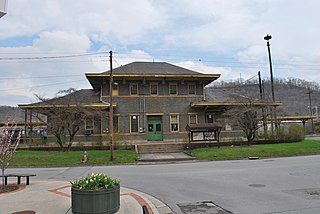
Ronceverte Historic District is a historic district in Ronceverte, West Virginia, United States, that is listed on the National Register of Historic Places.

The Downtown Morgantown Historic District is a federally designated historic district in Morgantown, Monongalia County, West Virginia. The district, encompassing approximately 75 acres, has 122 contributing buildings and 2 contributing sites including commercial and public buildings, residences, and churches. The district has been listed on the National Register of Historic Places since May 2, 1996. Ten of the contributing buildings are listed separately on the National Register of Historic Places. Significant structures located within the historic district are the Monongalia County Courthouse, the Metropolitan Theater, and the Old Morgantown Post Office.
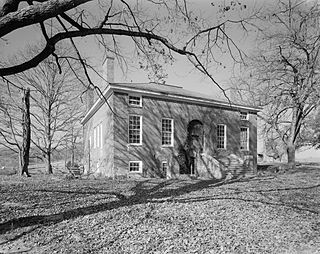
Lynnside Historic District is a national historic district located near Sweet Springs, Monroe County, West Virginia. The district includes six contributing buildings, three contributing sites, and two contributing structures. It consists of three contiguous properties related to the Lewis family home, known as "Lynnside." The main house was built in 1845 on the site of a previous plantation house, and is a 1 1/2 story, rectangular masonry dwelling in the Greek Revival style. It measures 70 feet by 40 feet. A fire in 1933, destroyed the roof and porticos. Also on the property are four wooden barns dated to about 1900. Located nearby is the Lewis Family Cemetery, that includes the grave of Virginia Governor John Floyd (1783-1837), and the adjacent Catholic Cemetery dated to 1882. The district also includes St. John's Catholic Chapel (1853-1859), a simple masonry Greek Revival style building, and the adjacent "New Cemetery."

Union Historic District is a national historic district located at Union, Monroe County, West Virginia. The district includes 174 contributing buildings, 2 contributing sites, 7 contributing structures, and 1 contributing object in the Union and surrounding areas.
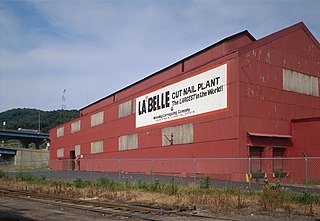
La Belle Iron Works, also known as La Belle Cut Nail Works, was a historic factory complex and national historic district located at Wheeling, Ohio County, West Virginia. The district included four contributing buildings; three Italianate style brick buildings dated to the founding of the company in 1852, and a tin plate mill built 1894–1897. After 1902, the buildings were combined under a single roof, although the truss systems date to different periods achieving the configuration visible today. When listed in 1997, it was known as the "La Belle Cut Nail Plant, The Largest in the World, Wheeling Corrugating Company, A Division of Wheeling Pittsburgh Steel Corporation." The cut nail machinery still in use by La Belle dated to 1852 and the 1860s. The machinery at La Belle along with the different processes were documented by the Historic American Buildings Survey team during the summer of 1990.
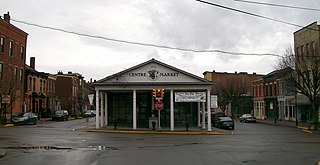
Centre Market Square Historic District is a historic district in Wheeling, West Virginia, listed on the National Register of Historic Places.

Chapline Street Row Historic District is a national historic district located at Wheeling, Ohio County, West Virginia. The district encompasses 10 contributing buildings, including eight residences. All buildings are brick with sandstone foundations. The first building was built in 1853, with some buildings added through the 1870s, and the last in 1896. The houses are in the Late Victorian style and are considered an architectural "super block."

Monroe Street East Historic District is a national historic district located at Wheeling, Ohio County, West Virginia. The district encompasses six contributing buildings. They are a Greek Revival style church built in 1837, a Roman-Tuscan style dwelling dated to 1852 and known as the Paxton-Reed House, and an eclectic 1881 dwelling. Also in the district is a Richardsonian Romanesque style apartment building and a set of vernacular post-American Civil War townhouses.
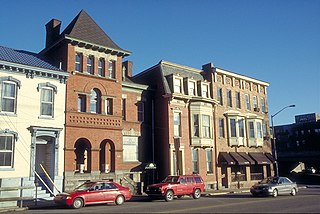
North Wheeling Historic District is a national historic district located at Wheeling, Ohio County, West Virginia. The district encompasses 134 contributing buildings and one contributing object in a 2 1/2-block section of northern Wheeling, known as "Old Town". Most of the district consists of mid- to late-19th-century residential buildings. A number of popular architectural styles are represented, including Greek Revival, Italianate, and Late Victorian. Notable buildings include the Vigilant Engine House, William Goering House (1885), Alfred Paull House (1880s), Williams Duplex Tenement (1880–1884), George W. Eckhart House (1891–1892), Christian Hess House (1876), Edward Hazlett House (1893), Henry K. List House (1858). The object is the Pollack Memorial Monument (1916).

Wheeling Historic District, also known as the Wheeling Central Business District, is a national historic district located at Wheeling, Ohio County, West Virginia. The district includes 205 contributing buildings in the central business district of Wheeling. It includes the site of the original location of Fort Henry. The buildings are representative of a number of popular architectural styles from the early-19th century through the present including Greek Revival and Late Victorian. The District was listed on the National Register of Historic Places in 1979.
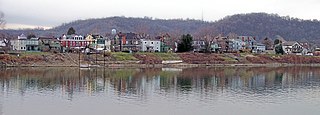
Wheeling Island Historic District is a national historic district located on Wheeling Island in Wheeling, Ohio County, West Virginia. The district includes 1,110 contributing buildings, 5 contributing sites, 2 contributing structures, and 3 contributing objects. It is a largely residential district consisting of two-story, frame detached dwellings built in the mid- to late-19th and early-20th century, including the Irwin-Brues House (1853) and a number of houses on Zane Street. The houses are representative of a number of popular architectural styles including Bungalow, Italianate, Queen Anne, and Colonial Revival. Notable non-residential contributing properties include the Exposition Building (1924), Thompson United Methodist Church (1913-1915), Madison School (1916), firehouse (1930-1931), the Bridgeport Bridge (1893), the Aetnaville Bridge (1891), "The Marina," Wheeling Island Baseball Park, and "Belle Island Park." It includes the separately listed Wheeling Suspension Bridge, Harry C. and Jessie F. Franzheim House, and John McLure House.

The Riverside Iron Works Office Building is a historic commercial building at 1507–09 Main Street in Wheeling, West Virginia. It is a four-story masonry structure, triangular in shape, and built out of light-colored brick with stone trim elements. The first three floors, built in 1896, are Richardsonian Romanesque in style, with rusticated stone elements on the ground floor at the rounded corner, and round-arch settings for doors and windows. The fourth floor, simpler in style, was added about 1907. It was built for the Riverside Iron Works, Wheeling's leading steel manufacturers at the time, and served as its headquarters until 1898, when the company was acquired by National Tube Company. In form, it is a flatiron building.























